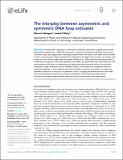The interplay between asymmetric and symmetric DNA loop extrusion
Author(s)
Banigan, Edward J; Mirny, Leonid A
DownloadPublished version (1.773Mb)
Publisher with Creative Commons License
Publisher with Creative Commons License
Creative Commons Attribution
Terms of use
Metadata
Show full item recordAbstract
© Banigan and Mirny. Chromosome compaction is essential for reliable transmission of genetic information. Experiments suggest that -1000-fold compaction is driven by condensin complexes that extrude chromatin loops, by progressively collecting chromatin fiber from one or both sides of the complex to form a growing loop. Theory indicates that symmetric two-sided loop extrusion can achieve such compaction, but recent single-molecule studies (Golfier et al., 2020) observed diverse dynamics of condensins that perform one-sided, symmetric two-sided, and asymmetric two-sided extrusion. We use simulations and theory to determine how these molecular properties lead to chromosome compaction. High compaction can be achieved if even a small fraction of condensins have two essential properties: A long residence time and the ability to perform two-sided (not necessarily symmetric) extrusion. In mixtures of condensins I and II, coupling two-sided extrusion and stable chromatin binding by condensin II promotes compaction. These results provide missing connections between single-molecule observations and chromosome-scale organization.
Date issued
2020Department
Massachusetts Institute of Technology. Department of Physics; Massachusetts Institute of Technology. Institute for Medical Engineering & ScienceJournal
eLife
Publisher
eLife Sciences Publications, Ltd
Citation
Banigan, Edward J and Mirny, Leonid A. 2020. "The interplay between asymmetric and symmetric DNA loop extrusion." eLife, 9.
Version: Final published version